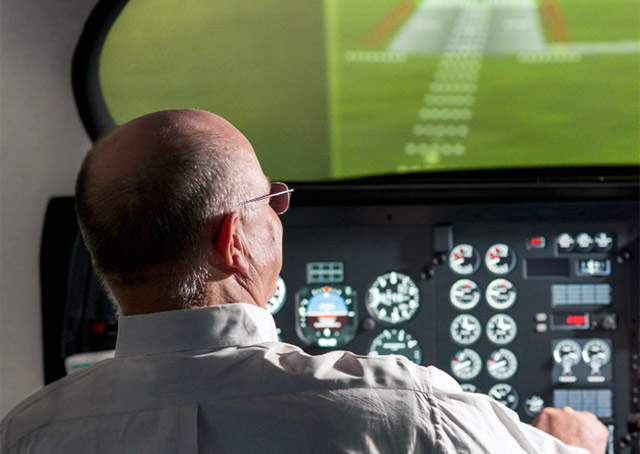Fundamentals
Back to school
Staying instrument-current means back to basics
Large simulator-based training centers can be intimidating on several levels. While there’s little doubt about the value of attending initial or recurrent instrument flight training at the FlightSafetys, SimComs, and other such institutions, pilots of turbine—and piston-powered—airplanes also can take advantage of less expensive, more personalized options. National Flight Simulator—previously named Nashua Flight Simulator—of New Hampshire is one alternative.
Based at the Manchester Airport in Manchester, New Hampshire, National leans heavily on the simulator software and hardware of Elite Simulation Solutions, FlyThisSim’s SimAVIO, and Laminar Research’s X-Plane 10 visual displays. The software selections cover dozens of different airplane types, so National can re-create the instrument panels and flight behaviors of everything from a Beechcraft Bonanza to a Cessna 421 or a Daher TBM 850. The software runs on a Windows platform, and templates replicating each aircraft’s individual panel are superimposed on computer screens to re-create the cockpit environment. The result is an enclosed flight training device with color visual displays visible through the “cockpit” front windshield.
While the visuals provide lifelike imagery of terrain and runway environments, National Flight Simulator President and CEO Stephen Cunningham believes that visual systems are not the most important component of simulator training. “Visuals are nice, and they provide a lot of ‘curb appeal’ that gets a lot of attention, especially by those who are fascinated by technology—and it’s not just millennials,” Cunningham said. “But we emphasize the basics here, and that means attention to instrument scan, instrument procedures, and situational awareness.” That translates into a lot of hand-flying using raw data—although National’s simulators are equipped with autopilots and flight directors.
On my visit to National, I got a sampling of the company’s King Air B200 instrument recurrency course, which involves 10 hours of classroom training and 10 hours in the simulator. Although the Elite setup certainly has the look of a desktop, it has a Garmin GNS 530 GPS/nav/com, and it’s certified as an AATD (advanced aviation training device) that’s all business. I found that out during one of many engine-out tribulations. Like all but the most sophisticated motion simulators, the Elite is ultra-sensitive and takes some acclimation. And while the simulator has a Bendix/King KFC 150 autopilot, I spent 95 percent of my time hand-flying the B200 on ILS and RNAV GPS approaches, missed approaches, and in holding patterns and other procedures. It was a good old-fashioned meat-and-potatoes IFR experience.
The visual display was the icing on the cake. Not that I saw all that much. Almost all of my takeoffs, approaches, and landings were to minimums, so I had a lot of practice looking for some very welcome centerline, lead-in, and approach lights.
Scott Wharen, my instructor, has 8,000 hours flying King Airs, and he’s one of National’s 15 contract instructors. The instructors—all of them highly experienced in type—either teach out of the Manchester facility or come to your location. National trains some 375 pilots per year, with 125 of them in instrument recurrency programs required by insurance providers. Many times, courses are combined. For example, an instrument recurrency course can be tailored to also provide an instrument proficiency check and a flight review. The only caveat is that the latter two programs require flying an airplane. The IPC requires demonstration of unusual attitude recoveries and circle-to-land maneuvers; the flight review requires a general review of maneuvers and procedures.
Wharen says lousy instrument scans are the most common shortcomings he sees among his instrument recurrency students. “They may fly 50 hours a year, but 48 of them are on autopilot. So we see them having trouble hand-flying on raw data when they come in here,” he said. “Another problem is an overdependence on technology, whether it’s moving maps, ForeFlight, or any of the other tablet-based programs. It’s information overload. This diverts their attention from basic control of the airplane, which shows up when there’s an engine or system failure. Let’s get back to flying the airplane!”
Recurrent training packages run less than $2,000 for those flying piston twins, $3,000 for turboprop twins, $2,500 for single-engine turboprops, and $1,500 for high-performance piston singles. A second pilot is charged half those prices. Initial instrument training prices run roughly double the above and include 35 to 40 hours of training—with 15 hours of ground school, 15 hours in the simulator, and five to 15 hours flying.
Email [email protected]
Web: www.nationalflightsimulator.com
Tips from a pro
Here’s some thoughts on instrument hand-flying from National Flight Simulator instructor Scott Wharen:
• Don’t do anything in a turn when you’re hand-flying. Concentrate on flying the airplane, not tuning radios or entering navigation procedures in your GPS. You can easily end up in a steep bank, lose altitude, or end up in an unusual attitude.
• The airplane follows your eye movements, so have it trimmed and flying level before, say, reaching over to perform communication or navigation chores.
• Don’t be tempted into positioning the airplane’s pitch attitude so that the runway approach lights fill the windshield on short final. You may land short.
• On a missed approach, use power to assist in the transition to a climb. Don’t pull up at first or your airspeed will decay. Adding power will automatically cause the airplane to pitch up, so apply nose-up pressure simultaneously. In the initial stages of a missed approach, power is primary. —TAH






